 |  |
By Martina
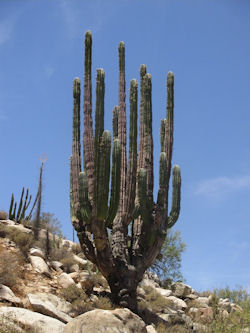
Baja Sur is a land of harsh reality and stunning beauty. It requires something more from the traveler who ventures beyond the cities of Baja Norte. It asks that you participate more fully and pay close attention to the moments of now. Many have said that just after El Rosario is where the real Baja begins. For the first time visitor there is a 3-day weekend trip as a beginning exploration of this region. The bio-reserve has some of the most beautifully strange landscapes to be seen anywhere on the peninsula.
As if entering another world, the landscape changes an hour past El Rosario. You are entering the land of the Cardón and Cirios people. Well, it is just my take on it, as their forms vibrate with life. Image a cactus weighing an impressive 10 tons and living over 200 years. One wonders how there is enough water to sustain this massive form. Cardóns are capable of storing huge quantities of water as an adaptation for survival. Their girth expands and contracts with rainfall. They are the whales of the living desert. In the same region, the Cirios or Boojum Trees remind me of Doctor Seuss characters, coming up from the ground like inverted carrots. When there is rain, they sprout thick green leaves in 72 hours and bloom yellow top hats beginning in July. The oldest known is thought to be 360 years old. The closer you get to Cataviña, the more powerful the land becomes with jumbled volcanic boulders piled on one another with all manner of unique plantings by a master gardener. This is an extraordinary visual experience.
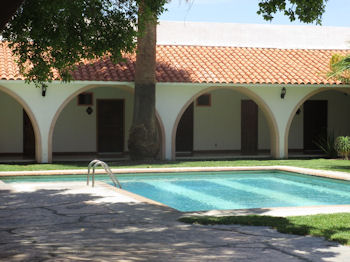
For total ease and comfort, make your destination Hotel Cataviña, a true oasis in the middle of the vast desert. Entering the front door is like stepping into an old hacienda with inner court yards, fountains and swimming pools. Luscious trees seem to actually sing, being filled with happy birds. A very good breakfast is served and the handmade corn tortillas are almost worth the whole drive down. The large air conditioned rooms start at $90 for a double. The little pueblo of Cataviña is fully supported by solar panels, but the hotel is still powered by generators. I asked why the hotel didn't have solar as well, as the sun pours its free source down to be used by all. The front desk clerk just looked at me and shrugged.
There are other options for the more budget conscious. Two very rustic motels are located on the main road. I have never found anyone in the office, but it is open when you get lucky and find the person to help you. A campground is beyond rustic, however it is fenced with security at night. Be sure and bring everything you need. Water is available in barrels and the bathroom is part of the owner's own home. The more rugged traveler knows that often the experiences are worth a little discomfort. Waking up in the cool dawn stillness you put the coffee on. Just as the sun comes up, you take that first delicious sip and its fragrance wakes you up. At that moment you are one with your surroundings. This will never be experienced from a hotel room.
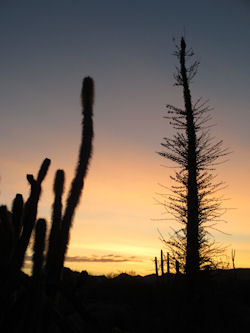
For an off the road choice, Santa Inés is one mile past the hotel and to your left. A short rough road takes you to a small 3-room lodging. The beds aren't great, but the cabins are off the main road so you don't hear the long haul truck traffic. There is a very special feel to this place. It is as thought the white granite boulders hold the history of the land's undersea and turbulant volcanic past. The ancient pine hears the wind-voices of the old ones moaning through its gnarled branches. It is a wind that has never known captivity. If you listen, it will tell you its secret.
All that remains of Mision Santa Marí is ruined structural walls and rock corrals. It was built by the Jesuits in 1769 to convert the Cochimi Indians. It was never successful and finally abandoned in 1818. The Cochimi had lived successfully in this area long before recorded time. They called it the “arroyo of crags.” One of their cave paintings is located in a jumble of boulders just before Cataviña above a palm canyon with smooth granite rocks that fill with rainwater making lovely swimming pools. It is not hard to imagine the natives bathing and swimming in this natural paradise. No wonder the padres couldn't convert them. When you already live in heaven, there is no need to be instructed on how to get there. Both the small cave painting and the Mision's remains are easy afternoon adventures. Locals can point the way, or even take you there for a small fee.
Directions: the roads are good all the way from Ensenada. There will be two military stops before El Rosario. While they can be a bit unnerving, they are really looking for non-tourist items like guns and drugs, so if you are not carrying either, no hay problema. They may ask for important papers such as passport or your car information. Just be pleasant and give them a cold can of coke. You are the ambassadors from the north and an attitude of respect is everything.
It has been years since the gas station in Cataviña was opened. The ingenuity of the locals offers at least a way to top off the tank if you feel you need to, but if you fill up in El Rosario you will have no problem for the return north. Figure 6-hours from Ensenada for driving time. Bring your camera!
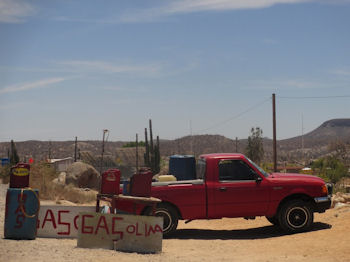
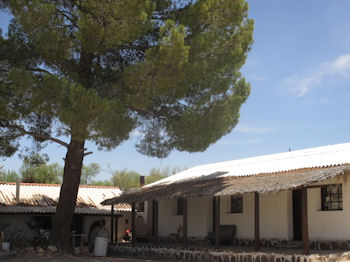
Hotel Misón Catavina - For reservations lapintacatavina@hotmail.com, (01-200) 124 91 23 Fax (01-200) 124 91 22
Hotel Santa Inés - Information not available
Martina's email: mteomaya(at)gmail.com

Signing up for policies is super easy. Never had a claim and hope I don't have to. But the service...

Excellent